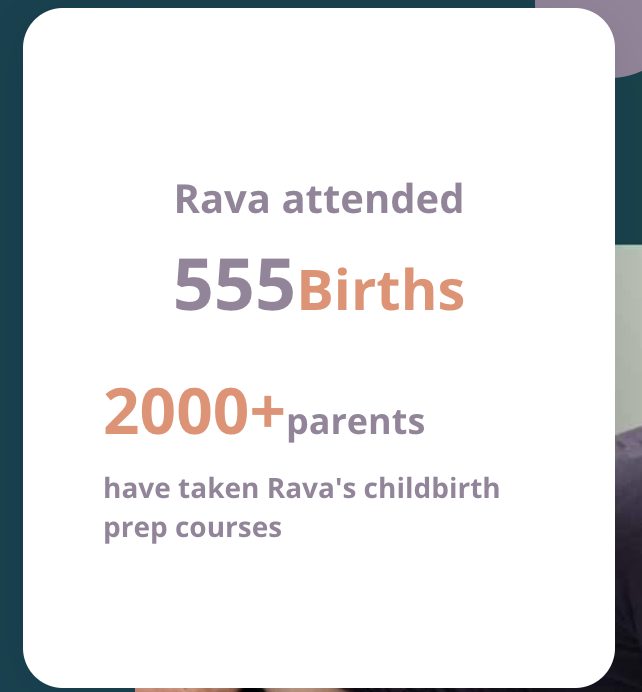The Ultimate Childbirth Preparation Course
This is RavaWomb's signature course that you take from the comfort of your home at your own pace. The knowledge, tools, practices and guidance are delivered in 4 ways: >> Primarily video with Rava teaching adjacent to slides, images, video, illustrations >> Audio tracks >> Some written material >> Links to additional information and recommended birth videos
>> In your birthing plan: an arsenal of tools rather than only a list of your preferences and wishes.
>> Skills and techniques to manage pain, intensity, anxiety — ones that are tried and true and really work.
>> Tools and skills that are above and beyond the basics of massage oil, chosen music playing, aromatherapy and a supportive partner and Birth Team.
>> Practices that you - the person giving birth - do within your own mind and body to ride the waves of those uterine contractions.
What's Included? All of the 13 modules that are on this webpage
You have access with a username and password to your own portal where you access all your courses. Access from your browser or in our app. As always if you have any questions do reach out.
Also included is a 100% discount on a 1:1 session with Rava. Value: $150 (Cdn$). 30 minutes to talk about whatever is on your mind —after you've taken the course.
Are you afraid of childbirth pain?
Are you uncertain about what the pain of childbirth really feels like?
Are you feeling anxious that it might be the most pain you've ever experienced in your life so far?
Likely believing what western culture brainwashes us to think: that it is the worst pain in the world?
We have seen that this is the script in movies and tv shows right? Because drama sells. If birth was portrayed as more calm and not excruciating it would be boring to watch.
Do you think that you'll be able to get an epidural at 1 cm dilation?
Do you think sometimes that you just don't know how you might be able to cope with it other than with an epidural? Or maybe you've heard that an epidural can be ok (it definitely can be).
You might be surprised to hear that the timing of it is actually really important, so that it doesn't affect your labor? I'm here to tell you don't believe that it's an absolute an epidural will lead to Pitocin or will lead to a caesarean birth; that can happen but usually it's more likely to happen if you have an epidural at the wrong time in your labor.
Are you worried about being turned away at the Labor and Delivery unit and sent home?
Have you been thinking about how you’ve been told they don't accept you into the labor and delivery unit until you're at a certain stage in labor (in Canada this is true, in other countries also, and in other countries it depends on the type of hospital you give birth in).
So you know you won't be able to get an epidural the second your labor starts, so you're wondering how you're going to cope up until that point?
So... if you are having any of those thoughts, then it's likely you don't yet have what you'll need to get through childbirth.
Limited time offer of
$725
value
$725
$417
Are you thrilled about your baby, but have fears, concerns and questions
about birth, parenting, the postpartum or breastfeeding experience?
Going in blindly, and just hoping for the best, almost always results in suffering, struggle and often even birth trauma. Instead gain priceless confidence in yourself!

Spend time with these modules that contain Rava’s deep well of knowledge so you'll be ready.
Learn from a veteran birthkeeper who has educated 2000+ couples, an expert in childbirth gained from 28 years as a doula and childbirth educator.
Option 1:
The Ultimate Childbirth Preparation Course
Option 2:
Birth Bites Mini-Courses
Advantages of Birth Bites: they cover One Topic at $55 cad each. Take one or combine several to create your own custom childbirth prep. If all modules are purchased separately they amount to $725 cad so your best value is the The Ultimate Childbirth Preparation Course at current offer of $417 cad

Waterbirth and Hydrotherapy
for pain relief
>> The science behind why water helps with pain
>> Making water work the most for you in labor is not as simple as getting under the showerhead or in the tub or birthing pool
>> Learn the common pitfalls to avoid (including how to ensure using hydrotherapy doesn't actually make the total number hours of your labor longer)
>> Everything you need to know about waterbirth. You'll get the tried and tested doula and midwife tricks, info and tips that you will not find by searching online.
>> Modules include: the science, physiology & how to make it all work for you. The research & benefits. Positions. Images and video of waterbirth with commentary and explanation.

Guided Meditation and Hypnosis
Preparation for Childbirth
Calm your nerves, alleviate stress and regulate your nervous system right now during your pregnancy and when you are in labor.
Listen to these audio tracks NOW to:
>> sleep better all through your pregnancy
>> create a deep sense of calm
>> dissolve the stress you are feeling
>> give you relaxation and rest and rejuvenation for your mind, body and spirit
>> build the mindset you need for giving birth
>> help prepare you for the arrival of your new baby
>> set the foundation so your mind is receptive to using these same techniques for the birth
>> develop your ability to remain calm and focused - no matter what's happening in your body or around you
>> discover that with support it is possible to have negative thoughts drift away, and be replaced with that powerful positive mind-set that is more helpful to your pregnancy and to your birth and postpartum experience
- This training is a combination of guided meditation, hypnosis and relaxation.
No doubt you have noticed there's a lot going on for you! All the changes within your body as well as so much preparation to do. And thoughts of "How am I going to actually birth this baby?" and "What do I need to know?" and "What can help me to be ready for this?"
These can be stressful thoughts so this program melts all that stress away at the end of a long day of working and growing your baby within you.

The Golden Hour
>> How to protect the "golden hour": the 1 to 2 hours after your baby comes into the world; and if you're having a hospital birth what to say and do to ensure this happens.
>> The importance of this period for the newborn, for the mother, exactly what it is, and common newborn procedures that can wait.
>> What is the partner's role in this? Quite crucial - learn why.
>> The 2 things that do not need to happen with your newborn!
Self-Paced Video Course

Maps of the Birth Journey
>> Physiologic birth - what is it. Is it possible to have an undisturbed (physiologic) birth in hospital?
>> What factors affect whether you'll have an undisturbed (physiologic) birth - or not.
>> You'll learn Pregnancy and Birth Anatomy
>> Understand the ligaments and muscles that you want to know about for more comfort in pregnancy and to get your body ready to give birth.
>> Understanding what it means to birth in a hospital - knowing the territory, understanding different providers that work in hospitals and how to choose one. Choosing your hospital.
Self-Paced — 2 hours of Video Lessons

Partner Support and Tools
>> Partners: learn how to manually use specific techniques in certain areas (using your hands, legs, tools etc.). What these techniques are, and how to do them correctly and effectively. These aren't massage techniques - they're something completely different. Massage is what is called a "comfort measure".
>> These techniques reduce labor sensations and pain she is experiencing by as much as 50% and when combined with other practices, the discomfort, pain, intensity can be reduced even more. All by you knowing what to do and how to do it - good news right? You'll be a rockstar in the birthspace! Don't be this guy 👆🏼
>> When to call, who to call, when to leave for your birthing place (if not birthing at home); how to time uterine contractions (it's not what you might think). The best apps for this (some are crap) and what settings you want on the app. And much more about this crucial part of your role.
>> Learn the common pitfalls to avoid when supporting your partner in labor (it's not what you might think).
>> Learn what tools and "stuff" that you need most for the labor —and how to use these tools.
>> Learn what items you do not need. This is especially important when birthing at hospital or birth center - so you don't end up bringing in four suitcases. Not very practical. And not necessary.

Coping in the Childbirth Year: Coping methods for your Pregnancy, Labor and early Postpartum time
>> This in-depth module gives you numerous coping techniques you can use in labor. >>These are the non-drug methods; the pharmacological options are covered in another module. However even if you use those options during labor, there's definitely an early phase of labor that you need to get through until the timing is right for an epidural. And these are the techniques you need to learn so you can cope during this early labor phase.
>> Techniques and practices that aren't just for labor! So that means you can use them now in your pregnancy for any discomfort or stress you might be experiencing. You can also use them in your postpartum period. Many RavaWomb clients write in reviews about how they've used them for the rest of their lives - they are that valuable.
>> As part of coping in labor it's important to know (especially for partners) what is happening and what best coping practisces to match with the moments. So this course includes modules on what happens in labor and how labor progresses. This course works well to be taken with the Maps of the Birth Journey.
Positions for All Phases of Labor and Birth

All the options for positioning your body for comfort and for effectiveness for bringing baby down and rotating baby - for all phases of labor, including the emergence phase.
>> Positions for Early Labor Phase (on land)
>> Positions for Active Labor Phase (on land and in water)
>> Positions for Transition Phase (land or water)
>> Emergence Phase - on Land
>> Emergence Phase - in Water

The Path of Labor
>> What actually happens in the body in childbirth? This course perfectly combines 1.) some of the medical jargon that you'll likely hear your doctor, midwife or nurse saying, so you understand what's going on in the birthing space; with 2.) explaining the path that labor takes in a way that is very clear and easy to understand.
Every birth is different so there's no way to give you an exact map of how your birth will go in terms of how long each part of it will take, but you will get a sense of the signposts along the way in the journey. This will help you to know where you're at. Partners find this extremely helpful, as it helps them to have a sense of what is going on, instead of feeling completely in the dark.
>> This course also covers the all-important birth physiology —with incredible graphics and illustrations, only available to childbirth educators. You won't find this anywhere by googling it.
>> Come learn from the experts because just about every woman that's been through childbirth will tell you that if she hadn't known what's going on inside of her body (and couldn’t connect the sensations that she was feeling to that knowledge) that she would've been in way more fear. And fear in childbirth causes physical pain.
Pharmacological Pain Relief Options

- Regional Anesthesia: Epidural and Spinal
- Narcotics Used in Labor
- "Gas" - Nitrous Oxide
Learn what all the options are; which ones are used in prodromal labor, vaginal birth, cesarean birth.
Learn best strategies in some cases for the use of these options.
Mindset for Birth

How do you truly prepare for birth? Comfort measures, yes, but those will not be enough
Train to gain the mindset and skills that will truly help you when you are in labor, and yes even if you plan to have an epidural
Induction and Augmentation of Labor

As the saying goes in the childbirth world: if you don't know what your options are, you don't have any.
Options for Monitoring Your Baby's Heart Rate while you're in Labor

Did you know that monitoring your baby's heart rate when you are in labor is one of the most important & primary ways that your midwife or doctor monitors the well-being of your baby? And did you know that there a few ways this can be done, and that you do have options to choose from? You may have a preference, you could include this in your birth plan, and also it's good to be educated about when a certain option might be more ideal than another.
Cesarean Birth

When giving birth to your baby via cesarean birth (either unplanned or scheduled) there is much you can do to prepare yourself in advance. Much you can learn so you can cope during the surgery, and there are so many options that you likely do not know you have.

